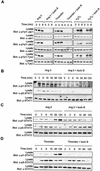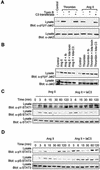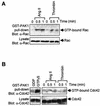Rho family GTPases are required for activation of Jak/STAT signaling by G protein-coupled receptors
- PMID: 12556491
- PMCID: PMC141129
- DOI: 10.1128/MCB.23.4.1316-1333.2003
Rho family GTPases are required for activation of Jak/STAT signaling by G protein-coupled receptors
Abstract
As do cytokine receptors and receptor tyrosine kinases, G protein-coupled receptors (GPCRs) signal to Janus kinases (Jaks) and signal transducers and activators of transcription (STATs). However, the early biochemical events linking GPCRs to this signaling pathway have been unclear. Here we show that GPCR-stimulated Rac activity and the subsequent generation of reactive oxygen species are necessary for activating tyrosine phosphorylation of Jaks and STAT-dependent transcription. The requirement for Rac activity can be overcome by addition of hydrogen peroxide. Expression of activated mutants of Rac1 is sufficient to activate Jak2 and STAT-dependent transcription, and the activation of Jak2 correlates with the ability of Rac1 to bind to NADPH oxidase subunit p67(phox). We further show that GPCR agonists stimulate tyrosine phosphorylation of STAT1 and STAT3 proteins in a Rac-dependent manner. The tyrosine phosphorylation of STAT3 is biphasic; the first peak of phosphorylation is weak and correlates with rapid activation of Jaks by GPCRs, whereas the second peak is stronger and requires the synthesis of an autocrine factor. Rho also plays an essential role in the induction of STAT transcriptional activity. Our results highlight a novel role for Rho GTPases in mediating the regulatory effects of GPCRs on STAT-dependent gene expression.
Figures














Similar articles
-
Thrombin regulates vascular smooth muscle cell growth and heat shock proteins via the JAK-STAT pathway.J Biol Chem. 2001 Jun 1;276(22):18915-24. doi: 10.1074/jbc.M008802200. Epub 2001 Mar 16. J Biol Chem. 2001. PMID: 11278437
-
Reactive oxygen species regulate heat-shock protein 70 via the JAK/STAT pathway.Arterioscler Thromb Vasc Biol. 2001 Mar;21(3):321-6. doi: 10.1161/01.atv.21.3.321. Arterioscler Thromb Vasc Biol. 2001. PMID: 11231909
-
The type I angiotensin II receptor couples to Stat1 and Stat3 activation through Jak2 kinase in neonatal rat cardiac myocytes.J Mol Cell Cardiol. 1997 Sep;29(9):2513-24. doi: 10.1006/jmcc.1997.0489. J Mol Cell Cardiol. 1997. PMID: 9299374
-
IL-3 signaling and the role of Src kinases, JAKs and STATs: a covert liaison unveiled.Oncogene. 2000 May 15;19(21):2532-47. doi: 10.1038/sj.onc.1203594. Oncogene. 2000. PMID: 10851052 Review.
-
Thrombopoietin induces tyrosine phosphorylation of Stat3 and Stat5 in human blood platelets.Blood. 1996 Jan 15;87(2):439-46. Blood. 1996. PMID: 8555464 Review.
Cited by
-
Senescence Mediated by p16INK4a Impedes Reprogramming of Human Corneal Endothelial Cells into Neural Crest Progenitors.Sci Rep. 2016 Oct 14;6:35166. doi: 10.1038/srep35166. Sci Rep. 2016. PMID: 27739458 Free PMC article.
-
Proteomic analysis of plasma exosomes from Cystic Echinococcosis patients provides in vivo support for distinct immune response profiles in active vs inactive infection and suggests potential biomarkers.PLoS Negl Trop Dis. 2020 Oct 5;14(10):e0008586. doi: 10.1371/journal.pntd.0008586. eCollection 2020 Oct. PLoS Negl Trop Dis. 2020. PMID: 33017416 Free PMC article.
-
Melatonin receptors, heterodimerization, signal transduction and binding sites: what's new?Br J Pharmacol. 2008 Jul;154(6):1182-95. doi: 10.1038/bjp.2008.184. Epub 2008 May 19. Br J Pharmacol. 2008. PMID: 18493248 Free PMC article. Review.
-
Current Insights in Genetics of Sarcoidosis: Functional and Clinical Impacts.J Clin Med. 2020 Aug 13;9(8):2633. doi: 10.3390/jcm9082633. J Clin Med. 2020. PMID: 32823753 Free PMC article. Review.
-
Autophosphorylation of JAK2 on tyrosines 221 and 570 regulates its activity.Mol Cell Biol. 2004 Jun;24(11):4955-67. doi: 10.1128/MCB.24.11.4955-4967.2004. Mol Cell Biol. 2004. PMID: 15143187 Free PMC article.
References
-
- Aktories, K., G. Schmidt, and I. Just. 2000. Rho GTPases as targets of bacterial protein toxins. Biol. Chem. 381:421-426. - PubMed
-
- Ali, M. S., P. P. Sayeski, and K. E. Bernstein. 2000. Jak2 acts as both a STAT1 kinase and as a molecular bridge linking STAT1 to the angiotensin II AT1 receptor. J. Biol. Chem. 275:15586-15593. - PubMed
-
- Ali, M. S., P. P. Sayeski, L. B. Dirksen, D. J. Hayzer, M. B. Marrero, and K. E. Bernstein. 1997. Dependence on the motif YIPP for the physical association of Jak2 kinase with the intracellular carboxyl tail of the angiotensin II AT1 receptor. J. Biol. Chem. 272:23382-23388. - PubMed
-
- Ali, M. S., P. P. Sayeski, A. Safavi, M. Lyles, and K. E. Bernstein. 1998. Janus kinase 2 (Jak2) must be catalytically active to associate with the AT1 receptor in response to angiotensin II. Biochem. Biophys. Res. Commun. 249:672-677. - PubMed
-
- Babior, B. M. 1999. NADPH oxidase: an update. Blood 93:1464-1476. - PubMed
Publication types
MeSH terms
Substances
LinkOut - more resources
Full Text Sources
Other Literature Sources
Research Materials
Miscellaneous
